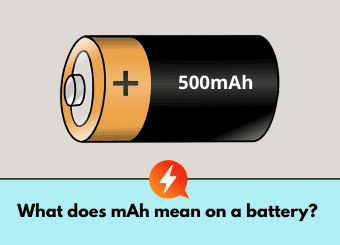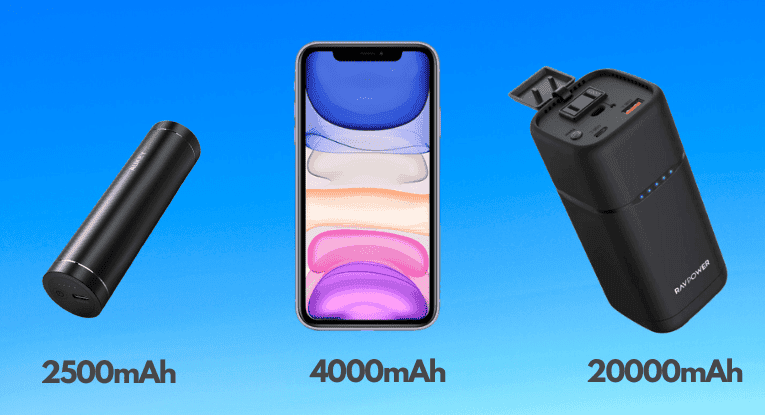
1mAh = 1/1000Ah (ampere hour)
The official abbreviation for milliampere hour is actually “mA-h” or “mA h”. However, almost all producers of devices that contain batteries, use the unofficial abbreviation: mAh. It’s also most commonly used without a space between the value and the abbreviation i.e. 10000mAh.
Furthermore “ampere hour” or “milliampere hour” are not capitalized when written fully. But when abbreviated the letter A from ampere is always capitalized: mAh and Ah.
Understanding mAh
 If we take rechargeable batteries, for example, mAh signifies the total energy charge that can be stored in the battery, but also the amount of time it can supply power to a device before it needs to be recharged.
If we take rechargeable batteries, for example, mAh signifies the total energy charge that can be stored in the battery, but also the amount of time it can supply power to a device before it needs to be recharged.
Depending on the type of battery, mAh consumption will be different. Still, one rule applies in most cases – the higher the mAh rating in batteries, the more electrical energy the battery can store. As a result, a rechargeable battery with a higher mAh is capable of powering a device for a longer time.
For example, a battery with a capacity of 5000mAh can provide power for a smartphone that takes in 100 mA for 50 hours. Thus, placing a 10000mAh battery on the same device provides fifty more hours of use, totaling 100 hours.
But the example above works just theoretically. In the real world, the power transfer from the battery to the device is inefficient, thus only part of the charge will actually be transferred. This is why the real battery capacity is different than the one stated on the product. We have covered this topic extensively in this article.
The Average mAh in Smartphone Batteries
Currently, the average capacity for smartphone batteries is marginally above 3300mAh, and the most popular sizes range from 2000 mAh to 4000mAh.
Although these sizes might seem relatively small, manufacturers have slightly increased the capacity compared to a few years ago. For example, before the release of the iPhone 6, the previous models were equipped with a 1500mAh lithium-ion battery.
However, 4000mAh batteries will not necessarily be the norm in the following years, as more and better-equipped smartphones will be available in the market.
For instance, the popular Samsung Galaxy A9 Pro comes with a 5000mAh battery that can go beyond a day without needing to recharge. In fact, some smartphones are equipped with 6000mAh batteries, such as the Samsung Galaxy M20.
More mAh = Longer Phone Usage Times?
The general public has developed a keen interest in knowing the battery capacity of their cell phones. This is done with the purpose of estimating how often the battery needs to be recharged. Travelers, in particular, are worried about how long the battery will last, especially during long flights. This is why many consider getting a portable charger, just to make sure they don’t run out of juice.
Thus, buyers are more aware of the fact that a battery with higher mAh will go on longer, and this is the reason why they check the capacity before purchasing a cell phone or replacing its old battery.
The battery life of a device will most likely be influenced by the type of usage as well. In other words, if the smartphone is used intensively, such as streaming music, playing video games, and watching videos, the battery will drain faster.
On the other hand, if the cellphone is used more conservatively, just for texting and making short calls, the phone will not need to be recharged very often at all.
Power banks are an alternative for extending battery life and cell phone use. For example, the iPhone 7 comes with a 1960mAh battery capacity that can last up to 14 hours of talking time and needs 2.5 hours to be fully charged. However, as in any iPhone, the battery is not removable, and thus replacing it for one of a bigger capacity might not be practical.
The truth is that while an average power bank of 10000mAh will not be able to charge the iPhone 7 battery 3.3 times, it can extend its life up to two times.
Nevertheless, knowing exactly how long a battery will last might be not that obvious. Technical specifications provide an estimate of battery life, but in reality, these values tend to differ as they vary according to brand and model, as well as the extent of use of the cellphone.
Does mAh Influence Battery Lifespan?
As an unwritten rule, the life expectancy of lithium-ion batteries, which are usually the norm for cell phone batteries, is around three years of constant use.
Rechargeable batteries have a limited number of charges before starting to wear out. According to some estimates, this limit is between 300 and 800 times on average. This number of charge-discharges is also known as cycle life. For this reason, usage habits are a factor that affects the average life of a battery.

But is capacity related to the actual lifespan of the battery? Does a larger capacity mean a longer or a shorter life? The answer is that the mAh value of a rechargeable battery does not influence its lifespan, but the way it is used. We have covered this topic extensively in this previous article.
Useful Formulas
The following concepts and formulas are convenient to calculate the performance life of phone batteries and make comparisons across different types of them.
mAh to Amps
As previously described, making this conversion is quite easy, as 1 amp entails 1000 milliamps. Concurrently, 1 ampere equals 1000 milliamps or 1 amp.
mAh to Watt-hours
The conversion of mAh to watt-hours can be done through the following formula: (mAh)*(V)/1000 = Wh.
For instance, the power of a 300mAh battery, rated at 5V, would be 1.5 Wh, as 300mAh * 5V /1000 = 1.5 Wh
In this sense, the Wh represents the amount of power that a battery can supply before dying.
For automatically making this conversion, you can use our mAh to Wh calculator.
Battery Life Calculation
Battery life can be calculated using the current rating in mAh and the load current of the circuit (smartphone), which maintains an inversely proportional relation.
Battery life = Battery capacity in mAh/Load current in mAh
In other words, the higher the load current will make the battery life shorter, and vice versa.
For instance, 25 hours and 5 minutes will have to pass before needing to recharge a 5000 mAh battery connected to a Samsung Galaxy A9 Pro with a load current of 195mA in talking mode.
Why is it Important to Know The mAh and Wh of Batteries?
Knowing the mAh and Wh of a battery is significant because it allows shoppers to identify how long the battery will last. As a result, they can invest in a device and a battery that will meet their needs.
Another very handy reason to know your battery’s Wh value is the fact that all batteries over 100Wh are not allowed on commercial flights. The TSA and FAA have specific rules regarding the maximum capacity of batteries allowed on flights. You can read more on this subject here.
Conclusion
To sum it up, the mAh meaning in batteries is a measure of capacity. The higher the mAh value is, the longer the battery life. However, this is not the sole indicator as the battery life will depend on usage patterns and the current output of the device, while the lifespan will depend on the number of charge-discharge experienced.
